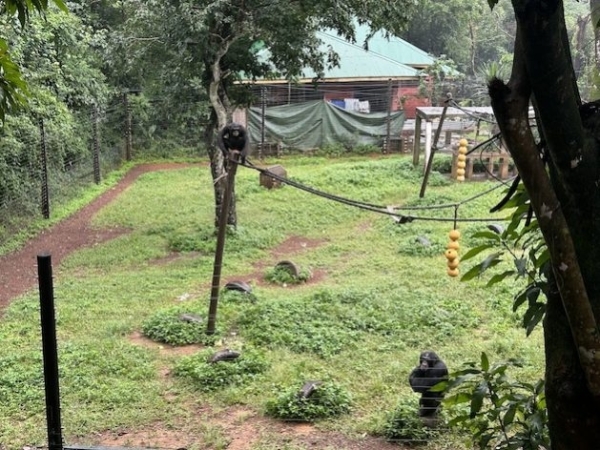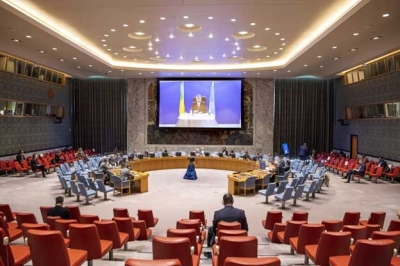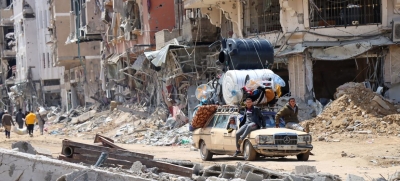FREETOWN, Nov 03 (IPS) — Thirty-three years ago, Bala Amerasekaran – a Sri Lankan by birth – visited Freetown, Sierra Leone. Since then, the West African nation has been his home, where Amerasekaran has dedicated his life to conserving the chimpanzee – Sierra Leone’s national animal.
In 1995, with support from the national government, he founded Tacugama Chimpanzee Sanctuary – the country’s first conservation center that rescues, rehabilitates, and protects chimpanzees, often hunted, traded, and killed for their meat. Currently home to 100 chimpanzees, the conservation works of the sanctuary also help prevent the spread of any possible diseases transmitted from primates to humans.
However, 20 years later, Amerasekaran’s enthusiasm is declining as he has witnessed massive encroachment within the sanctuary, destroying its forest cover and threatening the sustainability of the conservation program itself.
“I am beginning to feel that I have wasted my life for 28 years because there is no safety for this place,” says a visibly upset Amerasekaran.
Wildlife Connection to Africa’s Zoonotic Disease Trail
“At least 75 percent of emerging and re-emerging infectious diseases of humans—including Ebola, Marburg, Henipavirus, and zoonotic avian flu—have an animal origin, according to Hellen Amuguni – Associate Professor in the Department of Infectious Disease and Global Health at the Cummings School of Veterinary Medicine at Tufts University. “Chances are that when the next illness like COVID-19 emerges to threaten global health, it will originate in animals before it passes to humans, a process known as spillover,” Amuguni says.
West Africa has a long history of recurring zoonotic disease spillovers, the biggest of which occurred in 2014 when the region witnessed a devastating Ebola virus outbreak. The outbreak spread quickly across the entire region, including Guinea, Liberia, and Sierra Leone, where about 11,000 people died.
A 2018 study led by Caroline Huber of Precision Health Economics estimated that the disease outbreak also caused an economic and social burden worth over USD50 billion. Researchers later traced the origin to a spillover event: a two-year-old boy in Guinea likely infected while playing near a tree where bats roosted.
Since then, the conservation of biodiversity, especially the natural habitats of wildlife, has gained attention in the region to prevent any quick transmission of a zoonotic pathogen from animals to humans. But almost all the major forests and key wildlife habitats also face increasing stress from loggers, hunters, traders, and illegal builders.
An example is the Upper Guinean Forest, which covers the lowland forests of West Africa from Guinea to Togo. This forest is a global biodiversity hotspot and contains the world’s second-largest rainforest, the Congo Basin. However, studies have found that the forest has lost 84 percent of its original area, mostly due to agricultural expansion, commercial logging, charcoal burning, and human settlement.
Within the borders of Guinea – where the 2014 Ebola outbreak occurred first – 17.1-kilo hectares of humid primary forest disappeared between 2002 -2022, according to Global Forest Watch (GFW). To put it in perspective, this is the loss of a forest area as big as the city of Washington, DC.
GFW has also tracked large-scale deforestation in Equatorial Guinea –the country that reported the first cases of Marburg – a deadly viral zoonotic disease in May this year that claimed 12 lives. According to GFW’s estimates, in 2010, Equatorial Guinea had 2.63 mega hectares (Mha) of tree cover, extending over 98 percent of its land area, but by 2022, it lost 7.76 thousand hectares (kha) of tree cover, which is roughly the size of Paris.
Sierra Leone’s Vulnerable Forests
In Sierra Leone, several dense forests are habitats of many endangered wildlife species, including 6000 chimpanzees. These include Kangari Hills and Nimini Hills forests, Outamba-Kilimi National Park, and the Gola Rainforest – one of the largest remaining West African tracts extending to neighboring Liberia.
While deforestation has occurred in all these forests owing to illegal logging, unsustainable land use, infrastructural development, and charcoal production, it is particularly high in Gola Forest. According to a 2017 Purdue University research, the Gola forest has been losing its green cover at an annual rate of 4.18 percent. These losses are largely due to the expansion of rice farms within the forest area, says John Christian Abu-Kpawoh, who conducted the research.
In comparison, Tacugama Sanctuary is a tiny patch of forest of only about 40 hectares. Yet its proximity to the national capital, Freetown, a 40-minute drive away, makes it a prime target for encroachers. About 30 percent of the sanctuary has been encroached upon by builders, many of whom are powerful and well-connected.
“Last year, the Ministry of Lands deployed soldiers here (to protect the chimpanzee sanctuary). Yet every name that is coming up in the recent encroachments is of a soldier,” Amerasekaran reveals, indicating deep-rooted corruption in the government.
Worrying News for One Health
Since the COVID-19 pandemic, the One Health Approach to prevent a future zoonotic disease spillover has gained traction. The One Health approach recognizes the interconnection between human, animal, and environmental health and emphasizes an integrated approach to prevent any health crisis, especially related to infections transmitted from animals to humans.
Across West Africa, several large projects are already being implemented where multidisciplinary experts, including veterinarians, zoologists, epidemiologists, social behavior scientists, and risk communicators, are working together to prevent a new spillover.
The USAID-funded STOP Spillover, PREDICT and RESPOND, the Eco Health Alliance projects, and the West African One Health actions for understanding, preventing, and mitigating outbreaks are some examples.
These projects, among others, are engaged in studying and monitoring animal-human interaction, assessing risks of a possible disease breakout, putting surveillance measures in place to detect the early warning of spillover, and raising awareness among locals about the importance of conserving forest and wildlife to prevent a disease outbreak.
Tacugama Chimpanzee Sanctuary is also working with local communities to address some of the threats being faced by the rainforest-dwelling species. For example, the sanctuary is helping to establish livestock rearing projects, setting up swamp rice plantations, improving fuel efficiency of cooking, setting up tree nurseries for sustainable harvesting of wood and food products, and running education programs for school children.
But the uncontrolled development and encroachment on the forest land pose serious threats to the success of these activities, the biggest of them being the shrinking of space between humans and animals.
Although the 2014 Ebola virus outbreak and spillover were attributed to bats, chimpanzees can also be responsible for a new Ebola outbreak as they can contract and succumb to the virus. Ebola has been a major reason for the declining chimpanzee population across Africa. Once humans come in contact with an infected chimpanzee or its body fluids, the deadly disease can be transmitted to humans – leading to a viral spillover.
This means every unmonitored handling of a chimpanzee, including its capture, to sell it as a pet or kill for meat poses a risk of a disease breakout simply because the hunter or the capturer cannot know whether the animal has contracted Ebola virus. On the other hand, protecting a chimpanzee’s natural habitat and ensuring it stays within that habitat not only leads to its conservation but also prevents it from passing on any deadly pathogen, such as Ebola, to humans.
‘Learn from East Africa’
Considering the spillover risks, conserving the habitats of key wildlife species, especially those known to transmit viral zoonotic diseases to humans, is vital. Many feel West Africa can learn from its East African neighbors who have set examples of protecting their wildlife reserves by creating a safe distance between the wildlife and humans.
“Look at countries like Rwanda or Kenya, then you will see that where there is a wild reserve, they create a buffer zone of 2-3 kilometers,’’ says the founder of Tacugama Chimpanzee Sanctuary.
The failure to maintain this distance can pose serious risks to the region’s One Health goal, says Frederick Jobo Moseray, Assistant Conservation Manager at the sanctuary.
“When the forest goes, the animals become homeless. They then come to human colonies. Here, we are talking about chimpanzees. They are hunted, killed, and also kept as pets. All of this is dangerous. We are talking about preventing a zoonotic disease spillover, but first, we must stop the shrinking of safe space between humans and chimpanzees,” Moseray concludes.
IPS UN Bureau Report






